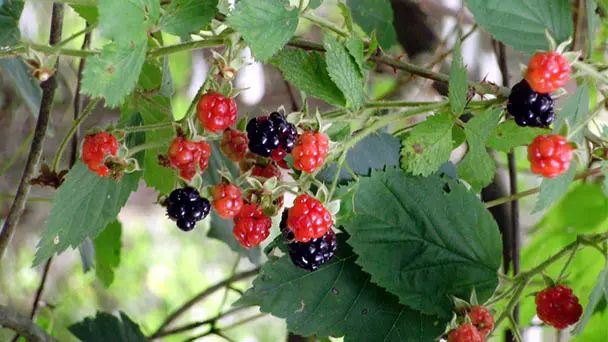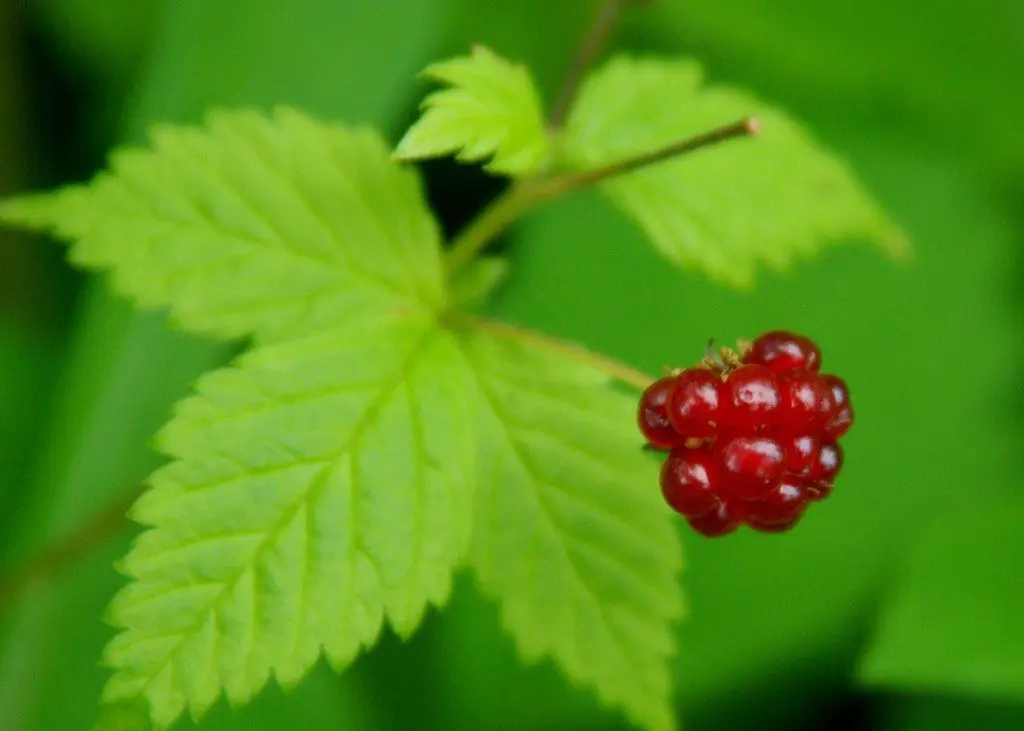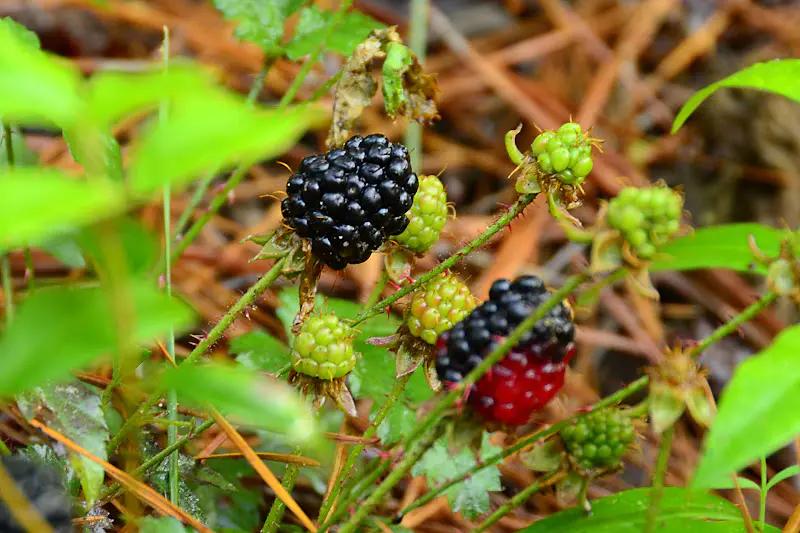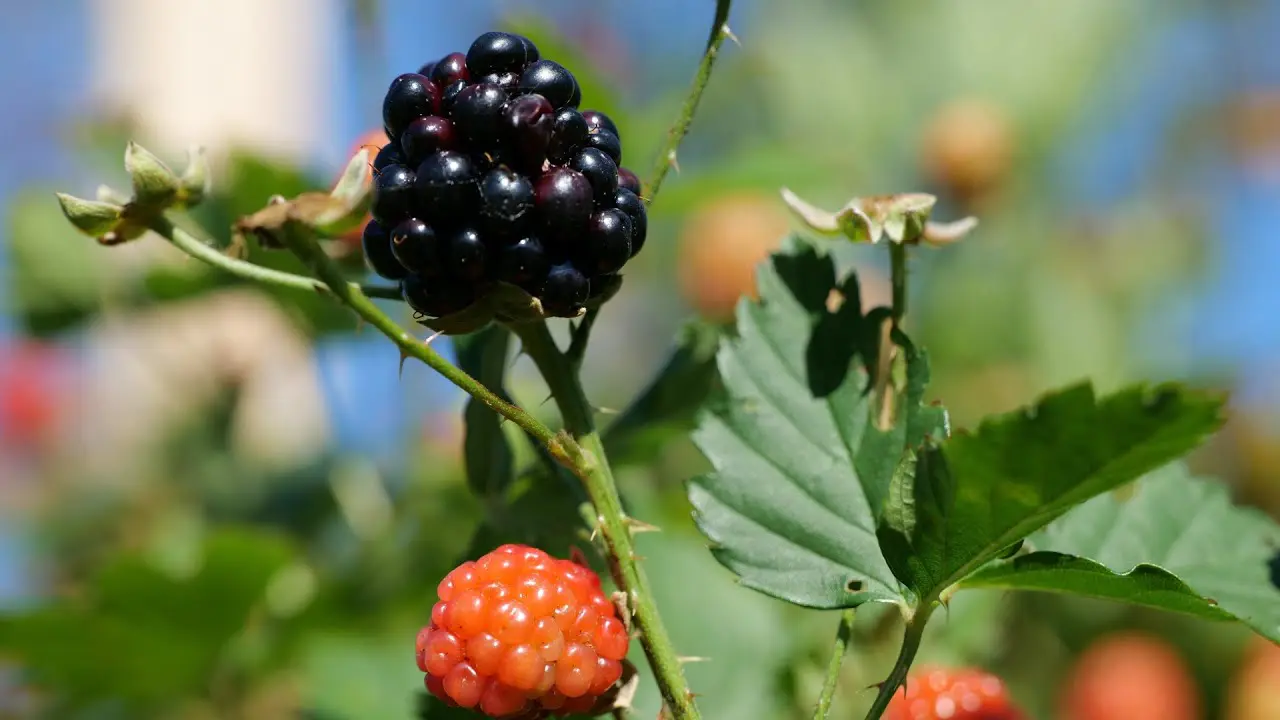How to Grow and Care for Dewberries (Rubus Flagellaris)
Written by Ivy
Nov 13 2021

Dewberries (Rubus Flagellaris) are similar to Raspberries and Blackberries. They have the same sweet taste, but Dewberries are smaller, usually purple. It is likely that Dewberry has similar health benefits to raspberries and blackberries. Dewberry fruit has a thin layer of wax on the surface, which makes the fruit look blue.

Read More:
Black Raspberries Care & Propagation
How to Grow Raspberries in Pots
How to Propagate Blackberry
From the flowering stage of Dewberry to the early stage of berry expansion, the temperature in the greenhouse during the day should be kept above 20 ° C, and the temperature at night should not be lower than 7 ° C. the relative humidity can be relatively low, but it should also be kept at about 60%. This temperature condition is conducive to Dewberry pollination and improve fruit setting rate, In the greenhouse from the expansion of berries to the early stage of harvest, the temperature should be kept above 25 degrees during the day, the temperature should be higher, the temperature at night should be at least above 10 degrees Celsius, and the temperature difference between day and night should be controlled above 10 degrees Celsius.
The greater the temperature difference between day and night, the better for Dewberry. Because the large temperature difference is conducive to fruit coloring and sugar content deposition, it can improve the yield and taste of blackberries. If the temperature in the greenhouse is too high, we can properly open the window for ventilation and cooling. Once the temperature drops too fast, we must close the ventilation window in time, Or cover it with some weeds to keep warm.
Dewberry's fertilization principle is to give priority to high-quality organic fertilizer, supplemented by chemical fertilizer, to maintain and increase soil fertility, improve soil structure and biological activity, and avoid harmful substances in fertilizer from entering the soil, so as to achieve the purpose of pollution control and environmental protection.
For the third time, Dewberry pruning, after falling leaves in autumn or before germination in early spring, according to the light cutting principle, all branches with pests and frozen branches should be cut off, and weak branches and too dense branches should not be used. Then cut off the remaining branches, divide them evenly and tie them to the shelf. Each plant can maintain 10 to 15 strong lateral branches, and the length of branches is 1.2 to 1.5m. If you need to propagate it, you can cut off the branches in winter, choose to bury it strong underground, and use Dewberry as a cuttings.
In Dewberry repotting, when we take blueberries out of the old flowerpot, we need to buckle down the root system at the bottom, but only part of it needs to be deducted. This is to break the balance of root growth and establish a new balance, that is, we can grow new roots again.
We must choose flowerpots with good water permeability, such as pottery pots or some plastic pots with holes at the bottom.
We can first put some subsoil into the Dewberry repotting basin. We must remember to deal with the root system before putting it in. The new soil added should not be buried too deep, just the same level as the original soil. Next, be sure to pour root fixing water to promote Dewberry to take root.
After Dewberry propagation from cutting, we should pay attention to watering more to keep the soil moist all the time, but we should not water too much, otherwise it is not easy to form roots. Fertilization is not required before Dewberry cutting, but it is necessary to apply fertilizer immediately after rooting, which can promote the growth of seedlings and facilitate the later transplanting.
In the greenhouse, the closer it is to the middle range, the higher the temperature. The Dewberry in this range matures earlier. However, the ambient temperature slightly away from the middle of the greenhouse is lower, and the fruit ripening is called completion. Therefore, it is necessary to harvest in batches. Generally, the fruit ripening in the greenhouse lasts for about a month from March to April, and can be harvested once in five to six days.
Dewberries Quick InfoWhen to Plant DewberriesWhen does Dewberries Bloom & HarvestDewberries Care in DetailDewberries WateringDewberries SoilDewberries LightDewberries TemperatureDewberries HumidityDewberries FertilizerDewberries PruningDewberries RepottingDewberries Pest & Disease Control1. Leaf rust2. Botrytis cinerea3. Ulcer diseaseDewberries Propagation from CuttingDewberries Benefits1. Eye protection2. Prevention of fetal malformation3. Strong bones4. Brain strengthening5. Heal the wound6. Anticancer7. Enhance immunityHow to Pick Dewberries
Dewberries Quick Info
| Botanical/Scientific Name | Rubus Flagellaris |
| Common Name | Dewberry |
| When to Grow/Bloom/Harvest | Bloom from early to mid spring/Harvest in late April to the first part of May |
| Uses | Used to make cobbler, jam, or pie |
| Origin | Americanized spelling of French Dubarry |
| Light Care | Full sun |
| Soil Care | Well-drained |
| Temperature Care | 47°F to 65°F |
| Humidity Care | Moisture |
| Watering | Water around the planting until the soil is moist |
| Pruning Care | Cut the narrow or unhealthy primocanes back to the ground |
| Fertilizer Care | General-purpose fertilizer |
| Propagation | From both seed drop and rhizomes |
| Toxic | Non-poisonous |
| Flower Color | White |

When to Plant Dewberries
Dewberry is usually planted in the early spring of each year. At this time, the density should be controlled. Generally speaking, it should be planted according to the soil fertility. Generally, for medium fertility soil, when planting Dewberry, the row spacing of plants should be controlled at about one meter multiplied by two meters, so as to ensure that Dewberry plants have enough growth space, If the soil fertility is relatively low and it is sticky soil, the method of ditch planting should be generally used. After digging the planting hole, the base fertilizer should be applied. At the same time, the bottom of the plant should be separated from the fertilizer to prevent root burning.When does Dewberries Bloom & Harvest
Dewberry has a long maturity period and should be harvested in batches. When Dewberry fruit changes from red to black, the texture changes from hard to soft. Harvest time should be between 5 and 10 a.m. The container used to collect fruit should not be too large or too deep to prevent the fruits from breaking and rotting each other. Fresh Dewberry after harvest must be processed or stored in cold storage every day, and all treatment must be completed the next day. Therefore, the processing plant must be built nearby.Read More:
Black Raspberries Care & Propagation
How to Grow Raspberries in Pots
How to Propagate Blackberry
Dewberries Care in Detail
Dewberries Watering
Before flowering, Dewberry watering is also very important. Generally speaking, drip irrigation can be used at this stage. This drip irrigation method can make the flower buds grow Fuller, ensure that the flower buds have enough water and nutrients, and improve the pollination rate and fruit rate. In the growth period of Dewberry young fruits, drip irrigation is generally used. At this stage, the young fruits develop rapidly, and the demand for nutrients and water is relatively high. Generally speaking, Dewberry irrigation is very important in order to reduce fruit drop and stabilize yield. At this time, the method of small water irrigation is used, and we can irrigate once a week, It can effectively improve the coloring degree of Dewberry fruit.Dewberries Soil
Before planting Dewberry, we should prepare and select the land. The growth of Dewberry requires relatively high soil requirements. We can choose the fertile soil with relatively convenient drainage and irrigation and deep soil layer. The pH value of the soil should not exceed 6.5. Moreover, the soil planted with Dewberry should ensure that the organic matter is relatively rich and sunny, At the same time, areas with good light conditions should be selected for planting.Dewberries Light
Dewberries likes to grow in a place with sufficient light. It needs to be planted in the sunny place to ensure good sunlight. If Dewberry lacks sunlight, its growth will be limited. The length of light time has a great relationship with flower bud formation. More than 16 hours of light leads to the failure of flower bud formation. When the light intensity of Dewberry is shortened, the number of flower bud formation increases, and the suitable short sunshine time is 50-65 days.Dewberries Temperature
Because many areas use greenhouse to propagate Dewberry, the two points that must be paid attention to in greenhouse management are temperature and humidity. Generally speaking, when the night temperature in the field drops to about 8 ℃, it is necessary to build a shed. In early November, at this time, Dewberry's flower buds have begun to differentiate, but the plant has not entered the dormant state. Generally speaking, From the germination stage to the flowering stage, the temperature in the greenhouse during the day should not exceed 24 degrees, and the temperature at night should be maintained at about 4 degrees to 10 degrees.From the flowering stage of Dewberry to the early stage of berry expansion, the temperature in the greenhouse during the day should be kept above 20 ° C, and the temperature at night should not be lower than 7 ° C. the relative humidity can be relatively low, but it should also be kept at about 60%. This temperature condition is conducive to Dewberry pollination and improve fruit setting rate, In the greenhouse from the expansion of berries to the early stage of harvest, the temperature should be kept above 25 degrees during the day, the temperature should be higher, the temperature at night should be at least above 10 degrees Celsius, and the temperature difference between day and night should be controlled above 10 degrees Celsius.
The greater the temperature difference between day and night, the better for Dewberry. Because the large temperature difference is conducive to fruit coloring and sugar content deposition, it can improve the yield and taste of blackberries. If the temperature in the greenhouse is too high, we can properly open the window for ventilation and cooling. Once the temperature drops too fast, we must close the ventilation window in time, Or cover it with some weeds to keep warm.

Dewberries Humidity
Dewberry is a small berry tree that likes high humidity. It is very sensitive to water supply and is neither drought resistant nor waterlogging resistant. The plant growth will be significantly inhibited under insufficient water, the leaves will wilt, the photosynthetic capacity will be significantly reduced, the quantity and quality of Dewberry which differentiated into flower buds from primary stems will be significantly reduced, the fruit setting rate will also be reduced, the berries will become smaller and the appearance will become worse. Excessive soil moisture will lead to insufficient soil air supply. Dewberry roots need more oxygen to survive, and insufficient oxygen will cause death.Dewberries Fertilizer
We should complete Dewberry ploughing once in winter, and use 0.5-1kg cake fertilizer as base fertilizer for each plant. Dewberry needs topdressing in the growing season. The first time is before flowering and the second time is the time of fruit development. During the period from June to July, if the precipitation is insufficient, it must be irrigated in time to ensure the development of Dewberry. If it rains too much, you must pay attention to drainage. You must do several times of intercropping and weeding throughout the growing season.Dewberry's fertilization principle is to give priority to high-quality organic fertilizer, supplemented by chemical fertilizer, to maintain and increase soil fertility, improve soil structure and biological activity, and avoid harmful substances in fertilizer from entering the soil, so as to achieve the purpose of pollution control and environmental protection.
Dewberries Pruning
The first Dewberry pruning was from May to June. When the seedling height reaches 1m to 1.5m, it is necessary to pick the heart, control the height and let the side branches grow well. Then, the twigs and side branches shall be tied to the iron wire in time to increase ventilation and light transmittance. Second, Dewberry pruning returned from August to September. When the fruit was harvested and the mother branch gradually turned yellow, the old branches were directly disposed of.For the third time, Dewberry pruning, after falling leaves in autumn or before germination in early spring, according to the light cutting principle, all branches with pests and frozen branches should be cut off, and weak branches and too dense branches should not be used. Then cut off the remaining branches, divide them evenly and tie them to the shelf. Each plant can maintain 10 to 15 strong lateral branches, and the length of branches is 1.2 to 1.5m. If you need to propagate it, you can cut off the branches in winter, choose to bury it strong underground, and use Dewberry as a cuttings.
Dewberries Repotting
When Dewberry roots are filled in the flowerpot, this is a reminder that you should change the pot. Dewberry repotting time is better in autumn, winter or early spring. If you don't change pots because of laziness, Dewberry's roots will become one, which means that it won't grow new roots.In Dewberry repotting, when we take blueberries out of the old flowerpot, we need to buckle down the root system at the bottom, but only part of it needs to be deducted. This is to break the balance of root growth and establish a new balance, that is, we can grow new roots again.
We must choose flowerpots with good water permeability, such as pottery pots or some plastic pots with holes at the bottom.
We can first put some subsoil into the Dewberry repotting basin. We must remember to deal with the root system before putting it in. The new soil added should not be buried too deep, just the same level as the original soil. Next, be sure to pour root fixing water to promote Dewberry to take root.
Dewberries Pest & Disease Control
Dewberry disease is not serious, but when the soil is too thin and no fertilizer is used during planting, Dewberry will shrink its leaves after germination. After strengthening management, if you encounter pests, you should also give different pesticides to different pests.1. Leaf rust
Dewberry leaf rust is a common disease. This disease is a destructive system. Infectious diseases will cause serious damage to leaves. When leaves grow, they will appear deformed and small. In autumn, the leaves will turn yellow. At the same time, many blisters will appear on the leaves, which is difficult to control. Generally speaking, The main prevention and control is to cultivate excellent disease resistant varieties, and spray some chemical agents, such as mancozeb.2. Botrytis cinerea
Gray mold is a common Dewberry disease. Generally speaking, it occurs in the season with low temperature and humid weather. Generally, when gray mold occurs in Dewberry, it usually occurs in the fruit ripening period. We can use chemical control methods, but we should choose mixed drugs in terms of chemicals, because the bacteria are resistant to fungicides.3. Ulcer disease
Ulcer disease is a common disease of Dewberries. The incidence rate is very high, and the pathogen is also much more. In the process of prevention and control, chemical spraying can be used to prevent and cure. But the most important thing is to prevent and strengthen the management of the field. If we find that there are old plant in the field, we must destroy these Dewberries plants and bring them out of the countryside. Moreover, we should pay attention to some daily bacterial control in the field and remove the overwintering bacteria in the soil.
Dewberries Propagation from Cutting
For the cuttings of Dewberry propagation from cutting, we should select the branches that grow more robust and have no diseases and pests. The selected branches must be hard, mature, healthy and have no diseases. If there are diseases in the orchard, we should keep a certain distance from the diseased tree during Dewberry propagation from cutting. The cutting branches should preferably be annual nutritional branches. If the branches are not enough, we can choose flowering buds, which is also OK. However, we should pay attention to erasing the buds when cutting in Dewberry, Can have better results. However, the rooting rate of flower buds and branches is relatively low, so we should prepare more when estimating the number. In the cutting of branches, the survival rate of lower branches is higher, so it is best to choose more lower branches as much as possible. Only when Dewberry branches are not enough, the upper branches and flower bud branches will be considered.After Dewberry propagation from cutting, we should pay attention to watering more to keep the soil moist all the time, but we should not water too much, otherwise it is not easy to form roots. Fertilization is not required before Dewberry cutting, but it is necessary to apply fertilizer immediately after rooting, which can promote the growth of seedlings and facilitate the later transplanting.
Dewberries Benefits
1. Eye protection
Lutein contained in dewberries can prevent the formation of retinal spots and UV damage to the eyes.2. Prevention of fetal malformation
There is a large amount of folate in dewberries. This substance is an important component necessary for pregnant women. It is particularly beneficial to fetal development and can reduce the occurrence of abnormal infants.3. Strong bones
Dewberry is an excellent food source of trace element manganese. A BlackBerry can meet 50% of the daily demand for manganese. Manganese helps the body form connective tissue and is essential for strong bones.4. Brain strengthening
Dewberry can help relieve the problem of excessive pressure on the brain. Eating BlackBerry meat alone, like walnuts, can help you strengthen your body and brain. Dewberry has strong brain tonic effect and is a tonic very suitable for mental activists.5. Heal the wound
Dewberry is rich in tannic acid. Experts say blackberries help tighten skin tissue, constrict blood vessels and reduce bleeding.6. Anticancer
Dewberry is rich in antioxidant anthocyanins. It is found that anthocyanins can inhibit the growth of tumor cells. In addition, Dewberry also contains a flavonoid called C3G, which can effectively treat skin cancer and lung cancer.7. Enhance immunity
The content of vitamin C in Dewberry is twice that of blueberry. Experts say that vitamin C can play a variety of important functions in the human body, help to strengthen the immune system, maintain cardiovascular health, reduce hypertension, improve the human body's absorption of iron in the diet and reduce the risk of anemia.How to Pick Dewberries
Dewberry's fruit is relatively fragile and easy to be damaged, so it must be picked with great attention. Sterilization and cold storage must be carried out within four hours, otherwise Dewberry's nutritional value will be lost greatly, and the fruit will deteriorate and the goods will be off the shelf. Moreover, Dewberry's market price is very expensive, Therefore, it is not easy to plant. You must pay great attention to picking after planting.In the greenhouse, the closer it is to the middle range, the higher the temperature. The Dewberry in this range matures earlier. However, the ambient temperature slightly away from the middle of the greenhouse is lower, and the fruit ripening is called completion. Therefore, it is necessary to harvest in batches. Generally, the fruit ripening in the greenhouse lasts for about a month from March to April, and can be harvested once in five to six days.
Latest Updated
- Benefits of Bugleweed - 7 Science-backed Health Benefits
- Bugleweed Dangers & Side Effects - Is It Poisonous?
- How to Plant Evergreen Trees - What You Should Know
- When to Plant Evergreens - Grow Guide for Evergreen Trees
- 12 Wonderful Evergreen Shrubs for Your Garden
- 12 Popular Evergreen Plants with Pictures for Beginners
- When And How To Prune A Lilac Bush Like a Pro
- How to Grow & Care for Lilac Vine (Hardenbergia Violacea)
- Japanese Lilac Tree (Syringa Reticulata) Care & Propagation Guide
- Shumard Oak Pros and Cons - What to Know
Popular Articles
- Winter maintenance of Antirrhinum Majus
- How to Grow Terminalia Mantaly Tree
- How to Grow and Care for Crossostephium Chinense
- How to grow Antirrhinum Majus in spring
- Peristeria Elata (Dove Orchid) Profile: Info & Care Guide
- Underwatered Snake Plant (Sansevieria Trifasciata) - Signs And How To Fix
- How to Care for Brazilian Jasmine Plant (Mandevilla Sanderi)
- How to Grow & Care for Graptopetalum Purple Delight in Summer
- Rosa Chinensis (China Rose): Plant Growing & Care Tips
- How to Care for Baby Sun Rose (Aptenia Cordifolia)